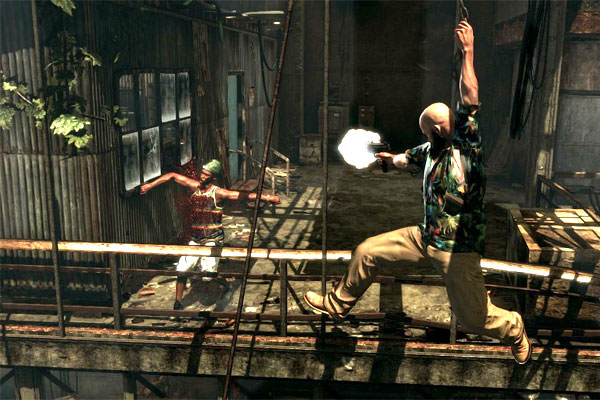Max Payne 3
Review
Just like the game itself, this review has begun with a noir, in media res opening (the game’s one is much better). Now, I’ll provide a bit of background. Max Payne 3 is the follow-up to Remedy’s Max Payne series, which blended a film noir-style New York detective story with Hong-Kong-action-crossed-with-The-Matrix gameplay. However, this time round, it is not Remedy at the helm, but Rockstar, creators of the famed Grand Theft Auto, Red Dead Redemption and Bully.
Max Payne 3 is a linear combat-centric game. It picks up the story of the titular character Max Payne several years after the events of the previous games. Max has fallen even further into despair. The third game centres on his addiction to alcohol and painkillers, but offers him a final chance at redemption. Rockstar chose to change the setting from wintery New York to sunny Săo Paulo, Brazil, while attempting to keep the noir feel. Overall, they succeed. Max is still as cynical and melodramatically poetic as ever, the story is a dark criminal conspiracy plot, and the cut scenes are very stylishly told. Indeed, the story telling is some of Rockstar’s best, which is saying a lot.
The gameplay further evolves Bullet Time from the previous games. The player can slow down time when shooting, allowing bullet dodging and fine aiming. This results in some incredibly cool gunfights – imagine diving out from cover with dual Uzis, and shooting all three bad guys in the head before you hit the floor. This is complemented by the animation physics, which give Max more natural movements. Slowing time down allows you to appreciate this. Bullet Time feels less powerful than in the previous games because of improved AI, more difficult aiming (slowing time also reduces the reticule movement speed), and its shorter duration. Despite this, pulling off a perfect Bullet Time is much more rewarding. The varied weapons are back and dual wielding combinations are as fun as ever. Max has lost his trench coat that can hold every single gun. Now, the player has to decide what single two-handed weapon he carries, resulting in tactical weapon choices. Overall, Rockstar has nailed the combat. While it is more difficult, it is a real pleasure to play.
Unfortunately, the game’s noir atmosphere isn’t as thick or as consistent as in previous entries. This is partly because of the change in setting – no amount of Max Payne monologue can fix the change from noir-perfect New York nights to daytime-bright Săo Paulo. Shooting up the favela in a Hawaiian shirt and killing Portuguese-speaking gangs doesn’t feel the same as exploring the twisted depths of a demonic New York nightclub. Secondly, the replacement of the comic book sequences with incredibly slick motion cut scenes doesn’t carry the amount of style or feeling that the incredible artwork did. The problem for old Max Payne fans is that Max Payne 3 is not a Remedy Max Payne game, with an over the top dark tone, colourful characters, and a twisted, surreal New York story. Instead, this is a realist Rockstar story about drugs, crime, and corruption in Brazil, all told through the noir perspective of Max.
Staring into the pale glow of the screen, I realise why I don’t like the game: it isn’t the Max Payne I expected. I wanted the old one back, but I wanted a new one at the same time. I killed several of my hours along with the strangers I killed online in the multiplayer, and I still wasn’t satisfied. Maybe some young punk who’d never played Max Payne in his sad life would be real happy with this – but I wanted a real Max Payne 3, and all I got was some shiny Rockstar version. All I can say is, bring on GTA V.
3 / 5 stars
– Vimal Patel



